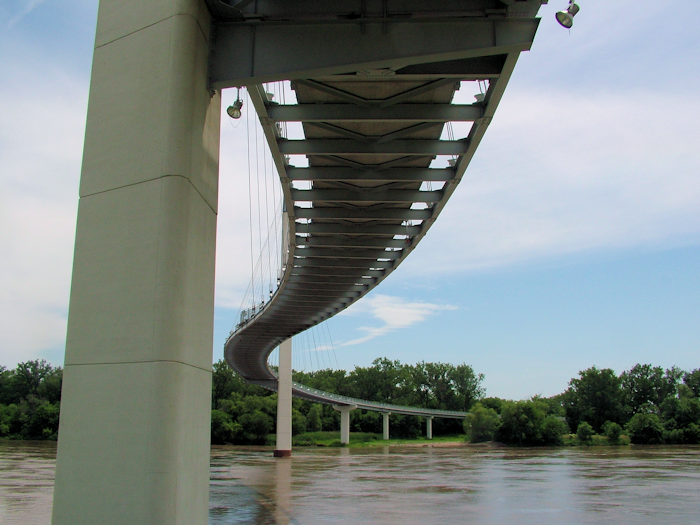
I said farewell to Jeanna at the Whispering Pines after a night interrupted by some eerie sirens, which we presumed were a tornado warning. It was very disconcerting. I was quite sad to say goodbye to Nebraska City. It had a real charm, and the icing on the cake was the new Lewis & Clark centre that opened for the bicentennial of the expedition in 2003.

This one focuses on the science of the trip – new species, the medical kit (patients were still treated based on the four humours), cartography etc. It also has a replica of the keelboat and an Indian earth lodge.

Omaha was the next stop. En route I crossed the Platte River, a major tributary of the Missouri and one that the Corps believed was a big contributor to the Missouri’s strong current and muddy waters.
Omaha’s a large city and a union city – certainly the biggest place I’ll see until I hit Portland, Oregon. Home not just to Warren Buffet (the investment guru known as the Sage of Omaha), but also to the headquarters of the Lewis & Clark Trail (in the background of the photo of the “Labor” statue). An extremely helpful ranger told me about some of the more unusual attractions in the western segment of the trail, while I gathered armfuls of leaflets.

Another of Omaha’s claims to fame is its brand new pedestrian bridge – the only one that connects two states in the whole of the United States (apparently).

So I walked into Iowa before retreating back to the Nebraska side of the river. Lewis & Clark camped at what would become downtown Omaha – roughly where this attractive bit of transportation infrastructure now stands.

At the end of July 1804, the Corps reached a prairie a few miles upriver from Omaha. This was a very significant moment of the trip as it was the site of their first council with Indian tribes – the Oto and the Missouri. These formal encounters with Indians were at the very heart of the expedition’s mission, which of course wasn’t just to find a water passage to the Pacific but to secure trade routes and bring peace to the newly purchased Louisiana Territory. Indeed most of their expenditure had gone on gifts/trade goods for the Indians they knew they’d meet.
Lewis had a four hour speech for all the tribal chiefs, which would be interpreted. And you thought my 20 second videos were bad! As we’ll see later in the trip, not all chiefs reacted well to the captains’ overtures on behalf of President Jefferson. But the Oto and Missouri tribes were fairly amenable.

Fifteen years later, Fort Atkinson was built on the bluff above the prairie. It was the first fort west of the Missouri and would for a time be the largest US military base in the country.

Thousands of troops were based here as part of the 6th Infantry and Rifle Regiment.

Clark, as with Fort Osage much further downstream, had once again spotted the potential of the location as the Corps passed through.

The Fort was eventually decommissioned in 1827 as westward expansion swung to the south and the Santa Fe Trail. The building was taken down log by log and most materials reused at other forts. For 100 years the site was nothing more than fields but, in the mid 1950s, archaelogical digs were able to fix the location of the forts and reconstruction began some 10 years later.